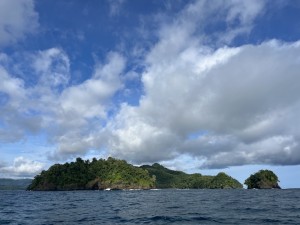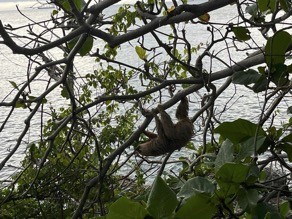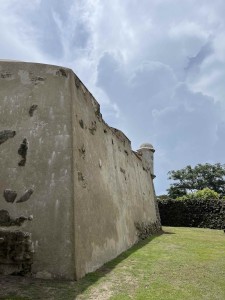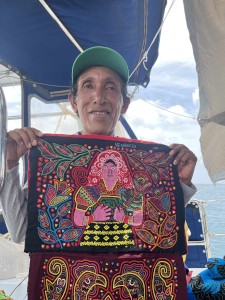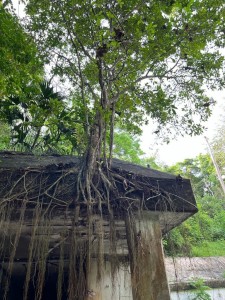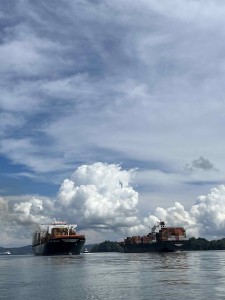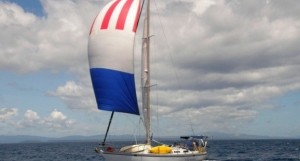Tokimata's Travels
| Vessel Name: | Tokimata |
| Vessel Make/Model: | Ganley S130 steel cutter |
| Hailing Port: | Coromandel, New Zealand |
| Crew: | Peter, Rachel, Danny and Tom Garden |
06 September 2023 | Bahia Nonda
Panama Pacific Coast
It’s now well over a month since we left Panama City. La Brisas the free anchorage on the long causeway joining three islands, was free but not the greatest pace to stay, with poor holding and many disintegrating boats, but this amazing backdrop of skyscrapers behind. These free places where yachts [...]
07 August 2023
Panama City
We fuelled up on 20th July 2023 and filled with water, ready for the passage through the Panama Canal. We were to leave around 2 pm next day, staying overnight in Gatun lake with our local line-handlers, and should be through by 3 pm on the following day.
21 July 2023
Rio Chagres and Portabelo on the Caribbean coast of Panama.
We left the San Blas islands on July 10 2023, after a last visit to Ivin, the wonderful chef at Hollandais Cays. He gave a few more image files for his recipe book and we bought his terrific coconut cake one last time. At 11.30 we upped anchor and were off on our way back east, the transit through the [...]
13 July 2023
The islands of San Blas
On Friday 23rd June at last we headed across the busy canal entrance from Shelter Bay marina and into the Caribbean sea. We were sailing to the San Blas islands, Kuna Yala to the inhabitants, hundreds of small islands and coastal villages that are still administered by the indigenous owners of the land. [...]
30 June 2023
The jungles of Panama
Grinding rust on the hull of Tokimata eventually gave way to grinding rust on the decks, but this was made much easier by hiring energetic boatyard workers. Eventually this progressed to painting, using two part polyurethane over the various anti-rust treatments and primers they had applied. However [...]
07 June 2023
Two weeks in Panama
We arrived in Panama City Tuesday 23rd May from Manchester, with our usual heavy luggage: this time a Starlink system was the bulk of it along with other boat essentials. After travel via Amsterdam we arrived at last to see our taxi-driver holding a “Mr Peter” sign and were off for the hour and a [...]
Ready to leave Nuuk
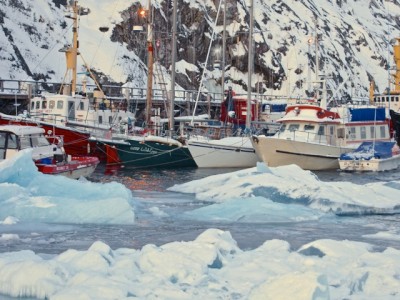
Things have worked out pretty well. I returned to the boat on 13th May (having left on 5th October - the day of the first snow of the winter). Tokimata was covered in a foot of snow, the cockpit full of it, and the temperature was below zero with quite a wind blowing. After a great meal on board "La Belle Epoque" with Claudia and Jurgen, and our Danish friends Kim and Kirsten from "Sol", I borrowed a shovel to dig out the cockpit and get on board. I had to get the kayak, folded up porta-bote dinghy and other big bits and pieces we had stored inside out on deck to make enough room in the saloon to sit down. After putting the chimney back on the diesel stove it was soon roaring away and over the next 18 hours the boat slowly warmed up from minus something to a comfortable 18 deg C inside. A storm came in over night and flights were canceled for 2 days as 40 knot winds and more snow came. All the water had been drained of course from the boat before I left, and so it was a treacherous icy walk along the dock in the gale to to fill up jerry cans from the small water shed ashore and to empty these into the tanks.
Tokimata had survived the winter well. One stainless stanchion holding the lifelines had been bent by a bump from a fishing boat, and a few mooring lines had chaffing damage (lesson learned: when it freezes for prolonged periods ice builds up inside plastic anti-chaff pipes and causes worse chaff than no protection at all!). The battery voltage seemed OK at 13.5V during the day with the solar panels which I'd raised to point south at 45 degrees pumping in 5 amps on a dull day and up to 15 amps in the sun. But I found the battery water level low in one of the 4 house batteries and despite adding water the level didn't come up. After removing the batteries I found one of them had a split down the corner from half way up to the top allowing acid to leak out. It had obviously frozen at some point. Jurgen said that when they came back alongside one time the solar panels were completely iced up and the battery voltage had dropped to 11.8V - this is low enough to allow a wet cell battery to freeze at -25 deg C - but if they had been at 12.6 V they would not have frozen. There is no power available on the commercial dock at Nuuk except for a couple of private supplies, so relying on solar panels is the only option - I should have mounted them at an even steeper angle to keep the snow off. Luckily only one battery was damaged and the leaking acid was pretty much contained in the battery compartment. I washed everything out with baking soda to neutralise the acid and then set about trying to find a replacement 6 volt deep cycle battery. Well it seems these US-style batteries are not used in Greenland at all. In the end our Danish friends were replacing their 12 volt wet batteries with AGMs that were available at a good price, and they offered me the best two of their old batteries and I fitted these in parallel with our remaining ones to get us back up to capacity. This should get us to the UK where we can buy the 6V deep cycles at a good price.
Some other minor repair and maintenance jobs kept me busy for the next 10 days or so. Despite the climate being quite dry in Nuuk, there seemed to be common theme of corrosion in electrical connections - something we hadn't had in Alaksa over the previous two winters when we had left Tokimata in the water. Even one of the main battery switches had failed, although this may have been just accumulated wear of 13 years since it was installed. Nuuk is well supplied with hardware stores, and a large excellently stocked chandlery/boat shop that has most parts you could want - and with no VAT sales tax in Greenland the prices are pretty much the same as Europe.
Over the 2 weeks before Rachel and my brother Phil arrived in Nuuk on 30th May, the weather slowly warmed up and by the time of their arrival all the snow had gone from the boat and it was a reasonable 5 to 8 degrees C during the day. Our friends on "La Belle Epoque" had headed north a week earlier to make a start on their Northwest Passage attempt in the opposite direction to us and Kim and Kirsten had got "Sol" craned back into the water from her winter berth on the hard stand.
Just before Rachel and Phil arrived I had been invited to a "boat warming" by Jens, a local who had salvaged a lovely British Saga 40 sailing yacht "Islander of Menai" that had gone aground south of Nuuk 18 months ago and been written off as a total loss. Jens bought the wreck for one pound from the insurers and after a month with water sloshing through her managed to patch the hull, refloat her and tow her back to Nuuk to get lifted out. Amazingly the rig was still completely intact with the sails all in place. He scoured the coast north and south of the wreck and recovered missing bits and pieces such as floor boards, hatches, lines and spare equipment. Over the 18 months he worked on the boat to bring it back to sea-worthy condition replacing some interior timber but managing to dry out and restore most of it. She is now renamed and ready to take Jens and his wife on a shake down trip to Denmark and back before heading further a field in a year or two. Jens has already sailed an old wooden trawler to the Caribbean and back and is looking forward to doing it in more style next time!
The day after the crew's arrival we had been invited on a day trip up the Nuuk Ice Fjord by Jakob, who I'd met when he came aboard the tour boat tied up next to us to do some guiding. He took us 3, along with Kim and Kirsten, in his 7 m launch at 25 knots around 100 km up the fjord where we had lunch drifting in the glacier ice at the head of the fjord. On the way back we stopped at an old settlement that had once had a thriving dried salt-fish processing plant but now the abandoned houses had been done up to be used as weekend and holiday retreats for residents of Nuuk. The weather was stunning and Jakob was a very knowledgeable guide to the area and gave us a great day out.
The 16 metre tour boat on which Jakob sometimes acts as guide was going out most days now as the tourists began to arrive in Nuuk. The main activity for the boat is whale watching and the Innuit skipper Aqqata ("Karl" for short) had told me each day how many humpbacks they had seen as he tied up rafted next to Tokimata at the end of each trip. Over the last week it had gone from one or two whales up to 10 on the 29th May. Then the next day he came in sadly to say the whales had all gone because one had been harpooned the day before. There is a quota set by the International Whaling Commission of a handful of humpbacks each year that can be killed in Greenland - one of those is for the Nuuk area and that was the one killed. It is clearly a source of contention between those who hunt the whales and those who make a living from the tourists. Jakob had showed us a leaflet with the tail fin patterns of dozens of humpbacks, some of which had been coming to Nuuk for may years, and others that were new comers only spotted for the first time this year. Aside from the small quota of humpbacks, and only 2 right whales (also called Bowheads in Alaska) for the whole of Greenland, Minke whales are the only species of whale still hunted in large numbers commercially. Whale meat is still eaten in Greenland, especially by the Innuit, and some controlled hunting in your own local waters does seem a reasonable compromise between the desire to continue the traditional way of life, and the desire of tourists to "see nature". While distressing it is very different to the situation in the Southern Ocean where the Japaneese having destroyed the whale fisheries in their own backyard and so come south of New Zealand and Australia to kill that wildlife.
After the Nuuk Fjord trip, the next day was spent provisioning and getting ready to leave. With so much food left over from the Northwest Passage trip we needed only a few fresh items. Last year we had carried huge quantities of rice, flour, pasta and tinned food in case we had a protracted stay in the ice and this is all usable this year.
Finally we headed out of Nuuk on Monday morning 3rd June. We topped up our diesel fuel at a price cheaper than the US, Canada and Europe (still the same price as least year - prices of diesel are the same throughout Greenland and only change when a new seasons shipment comes in). As we sailed out of the harbour with a 15 knot northerly wind behind us it started to snow! We're heading down the south west coast of Greenland and a little way up the east coast before sailing across to Iceland and then down to the Faroe Islands and on to Scotland. Stay tuned.
